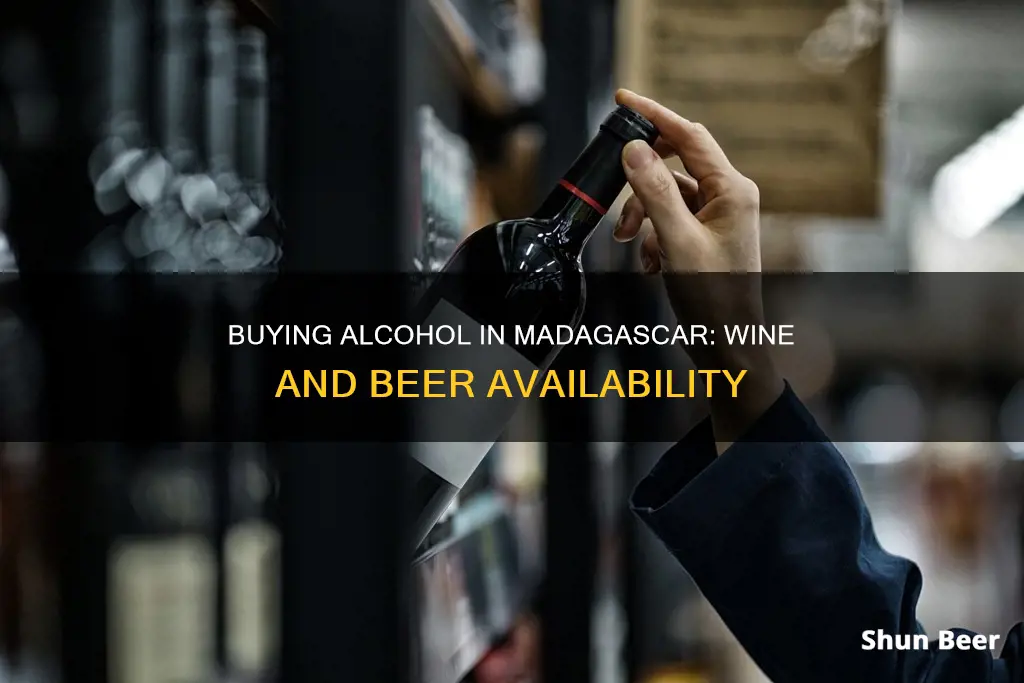
Madagascar, the fourth-largest island in the world, is known for its unique ecology and diverse flora and fauna. But did you know that it's also home to a thriving wine and beer industry? The island's climate and soil are well-suited for viticulture, and there are several dozen wineries producing a wide variety of wines. The local beer market, on the other hand, is dominated by a single brewery – the Madagascar Star Breweries, which produces the iconic Three Horses Beer (THB). So, whether you're a wine or beer enthusiast, you'll be able to find something to quench your thirst in Madagascar.
| Characteristics | Values |
|---|---|
| Wine availability | Wine is available in Madagascar, with several dozen wineries on the island producing a wide variety of wines. Local wines can be purchased at shops, restaurants, and hotels. |
| Beer availability | Beer is also available in Madagascar, with local brands such as Three Horses Beer (THB) and imported options. |
| Alcohol availability | Alcohol is available in Madagascar, but its availability may vary by location. Some areas may have limited or no access to alcohol. |
| Local drinks | In addition to wine and beer, Madagascar has a variety of local drinks such as rum, palm wine (trembo), "rice water," coffee, tea, and fruit juices. |
| Drinking water | Tap water is generally not considered safe to drink for tourists. Bottled water or disinfection methods are recommended. |
What You'll Learn

Madagascar's wine industry
Madagascan Wine Industry
Given its location, it would be reasonable to assume that Madagascar is not a wine-producing country. However, the large island off the southeast coast of Africa has a surprisingly strong winemaking legacy left by the French, who invaded in 1883 and relinquished control in 1960.
Several hundred small vineyards are scattered across the island, each home to just a few hectares of vines. These vineyards are slowly consolidating into larger businesses. However, very little wine is exported from Madagascar, with rum remaining the country's key alcoholic export.
The island produces over 7.5 million litres of wine each vintage, most of which comes from vineyards on the central plateau in the Hauts Plateaux region. This area is the national centre of both grape-growing and rice production, with thousands of hectares of rice paddies in the wetter spots of the valleys and vineyards on the well-drained slopes above.
The vineyards in the Hauts Plateaux region lie between altitudes of 500m and 1,500m, providing an escape from the tropical heat of the lower-lying coastal areas and creating a greater climatic balance for grape growing. The grapes are highly prone to fungal diseases in hot, humid environments, and the berries often reach high levels of potential alcohol before achieving phenolic ripeness. Therefore, most vineyards are located at cooler altitudes around the towns of Ambalavo and Fianarantsoa.
The vineyards in the Hauts Plateaux region are planted mainly with hybrid vines selected for the tropical climate, including Petit Bouschet, Chambourcin, and Villard Blanc. These French-American hybrids were created in the 1860s by crossing different Vitis species in Europe, aiming to combine the toughness of American vine sorts with the elegance of European wines.
While the exact acreage is unknown, vineyards in Madagascar are estimated to cover an area between 6 km² and 40 km². The industry is mainly controlled by French and Malagasy descendants of Chinese immigrants, with native vintners, mainly from the Betsileo people, administering only 40% of the vineyards.
The grape harvest in Madagascar typically occurs in February, at the end of the tropical rainy season. All stages of wine production are done by hand, and the sugar content of the grapes is determined through taste rather than using a refractometer. The pressed-out grape cider ferments for six months in large concrete or steel barrels, and wooden barrels are rarely used.
In addition to red, white, and rosé wines, Madagascar also produces a special type of wine called Vin Gris and various aperitif wines with coconut, pineapple, or orange flavours. Malagasy wine is generally unknown worldwide and often dismissed as inferior in quality. However, many wines from the country can be good table wines, and they have earned their place in the market.
Best Places to Buy Ultra Light Beer
You may want to see also

Local drinks
Wine production also has a long history in Madagascar, dating back to the French colonisation. While most of the wine is consumed domestically, some vineyards are starting to consolidate into larger businesses, with the potential for future exports. The Hauts Plateaux region, with its well-drained slopes and unique red laterite soils, is the national centre of grape-growing. Hybrid vines selected for the tropical climate, such as Petit Bouschet, Chambourcin, and Villard Blanc, are commonly cultivated.
In addition to rum and wine, beer is also produced locally. The Three Horses Beer (THB), brewed in Antsirabe since the 1960s, is the iconic Malagasy beer, recognised for its unique flavour. It is a source of national pride and is widely consumed across the island. Other beer brands include Gold and Queen, which are marginally more expensive and considered less fatty and tastier by some.
For non-alcoholic options, Malagasy people frequently consume water in the form of "ranonampango", which is made by boiling water with leftover rice, giving it a slightly bitter taste and a light brown colour. Natural fruit juices are also popular, with seasonal fruits like papaw, mango, tamarind, pineapple, and banana being used to create refreshing drinks.
Coffee and tea are additional local beverages. While coffee is a significant export product, tea holds cultural importance, with the famous vanilla-infused tea of Madagascar being a speciality.
Best Places to Buy Barq's Frozen Root Beer Float
You may want to see also

Imported drinks
The cost of imported beer in Madagascar can be higher than that of domestic beer, with a price range of around $1.50 for a can of local beer and $2.50 for an imported beer.
In addition to imported drinks, Madagascar also has a variety of local beverages, including rum, palm wine (trembo), red wine, coffee, tea, fruit juices, and beer. The local beer, Three Horses Beer (THB), is a popular choice and is considered a national symbol.
The island's unique climate and soil make it ideal for viticulture, and the wine industry has been growing steadily. There are several dozen wineries on the island, and many hotels and resorts offer a selection of wines for purchase.
The Best Places to Buy Carlsberg Beer
You may want to see also

Alcohol availability
Alcohol is available in Madagascar, though it may not be easy to find in some areas. The country has a thriving wine industry, with several dozen wineries producing a wide variety of wines. The local wine industry has been growing steadily in recent years, and there are a number of shops and restaurants that specialize in selling local wines. Many of the island’s hotels and resorts also offer a selection of wines for purchase. The most popular wine-growing region is the Hauts Plateaux, which has the ideal climate for grape-growing.
In addition to wine, beer is also available in Madagascar, though the country is not a big consumer of it. The average consumption is just 4 litres per person per year. The most popular beer is the Three Horses Beer (THB), a lager produced by the Madagascar Star Breweries, which has a monopoly on the beer market in the country. There are also a few other beers available, such as Gold and Queen, which are a little more expensive and considered less fatty and tastier.
Rum is the national alcohol of Madagascar, and there are several types available, including Dzama, a premium rum, and Toaka Gasy, a traditional rum made by local people in their villages, which is considered moonshine. Other alcoholic drinks include palm wine (trembo) and betsabetsa, a drink produced on the east coast made from fermented sugarcane juice.
Buying Beer on Easter: What's Open and Closed?
You may want to see also

Alcohol affordability
Wine Affordability
Madagascar has a thriving wine industry due to its favourable climate and soil conditions for viticulture. The local wine industry has been expanding, with several dozen wineries producing a diverse range of wines. The cost of wine can vary depending on the type and quality. A bottle of mid-range wine is estimated to cost around 1,839,550.7 Ariary (approximately $394) for a single person per month, excluding rent. However, the specific cost of wine in Madagascar is not widely available.
Beer Affordability
Madagascar has a national brewery, and the local beer brand is called Three Horses Beer (THB), which is a lager. Beer is also produced by other breweries, such as Castel Beer. The cost of a can of domestic beer is estimated to be around $1.50, while imported beer may cost around $2.50. The price may vary based on the time of year and special promotions. The average monthly cost for a single person, excluding rent, is estimated to be 1,839,550.7 Ariary (approximately $394).
Rum Affordability
Rum is the national alcohol of Madagascar, with a variety of options available, including Dzama, a premium rum, and traditional Toaka Gasy, considered moonshine. The cost of rum can vary depending on the brand and quality, but it is generally affordable for locals, with an average yearly consumption of 2.38 kg/person.
In summary, alcohol affordability in Madagascar varies depending on the type of beverage and brand. While specific price information is limited, wine and beer are available at varying price points, with domestic options generally being more affordable than imported ones. Rum, as the national alcohol, is also widely consumed and affordable for the local population.
Planning a Party: Buying Beer in Bulk
You may want to see also
Frequently asked questions
Yes, you can buy both wine and beer in Madagascar. The country has a thriving wine industry, with several dozen wineries producing a wide variety of wines. There are shops and restaurants that specialise in selling local wines, and many hotels and resorts also offer wines for purchase. Madagascar also has a national brewery, which produces the popular Three Horses Beer, as well as other beers such as Gold and Queen.
Apart from wine and beer, rum is the national alcohol of Madagascar. The country produces a variety of rums, including Dzama, which is considered a premium rum, and Cazeneuve, a white rum appreciated in punch. Another popular drink is the traditional "rice water" or "ranon' ampango", which is made by boiling water with rice and has a slightly bitter taste. Palm wine, or "trembo", is also consumed on the coast.
Alcohol does not appear to be widely consumed in Madagascar. The average beer consumption is very low, at 4 litres per person per year, compared to 40 litres in Mauritius or 95 litres in Belgium. The country also faces challenges with water safety, as approximately 56% of the population does not have access to safe drinking water.







